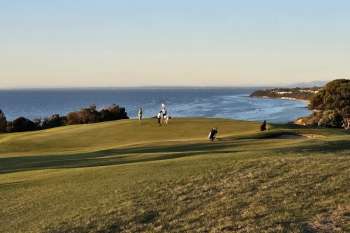DIRTY DOZEN - The 12 toughest shots in golf
What makes a golf hole memorable? It’s a question with endless answers, from beauty to celebrity, from strategy to difficulty or simply because it was the scene of an unforgettable personal achievement. A memorable hole might be a great hole or an unforgivably poor one. There are any number of reasons why certain holes stick in our memory, and golf course architects are forever looking to exploit human curiosity by creating shots that can be instantly recalled the moment a round ends.
This month we look at some of the toughest shots in golf, and examples in Australia where extreme difficulty has not only complicated the game but also made holes more memorable.
Forced Carries
Nothing stresses the average amateur more than a long, forced carry particularly when water or some other form of penal hazard is involved. Even otherwise straightforward par threes, such as the 7th at The National (Old), the 3rd at Narooma or the 3rd at Joondalup (Quarry), can torment golfers nervous about their ability to carry unplayable hazards. Even more frightening is the 13th at Sanctuary Cove (Pines), which plays 200m from the back tee and is all-carry across one of the resort’s largest lakes. The approach into the new 4th hole at the Ipswich Golf Club is another brutal example of the forced carry, this time an angled green is protected at the front by a deep and nasty ravine. Often the prudent play here is to lay-up short with your second and then try to pitch across with your third.
Narrow Fairways
As the USGA prove year after year, the easiest way to defend your golf course from low scoring is to narrow its fairways. Unfortunately doing so often destroys its strategic integrity. There are far too many narrow courses in Australia, and too many tee shots where trees dictate how golfers must play. One of the cruelest is the 4th at the unheralded Mornington Golf Club in Victoria, which is not only super tight but also angled so severely that the only way to keep balls from running into the left-hand trees is to slice a drive up into the right-hand rough. Other uncomfortably tight driving holes include the 13th at St Andrews Beach, the 9th at Brookwater, the 2nd at The Vintage, the 8that Moonah Links (Open), the 10th at Sanctuary Cove (Pines) and the famous 15th at New South Wales, where even the slightest spray is almost guaranteed to require a reload.
Uphill Approach Shots
Few would forget the first time they played the old 16th hole at The National (Old), with its partly-blind, tiered green perched atop a small ledge some 10 metres or so above the level of the fairway. Unless you bombed a drive here you needed to hit a career second shot just to reach the putting surface. With the new clubhouse and routing reconfiguration, the 16th hole is now the 3rdand those not fully alert and warmed up by this point in the round are almost certain to make a bogey or much worse. There aren’t many tougher examples of the uphill approach shot in Australia, except perhaps the 10th at St Andrews Beach. Other brutes include the 8th at Barnbougle Dunes, particularly from the lower fairway, and the 10th at Brookwater, which is also cramped uncomfortably on both sides by trees. The par three 15th at Kingston Heath is another wonderful example of a shot made more treacherous by the fact you can’t really see the putting surface.
Blind Shots
In many ways blind shots embody the very essence of traditional British links, which are generally sporty and fun and whose holes are often draped across landforms, rather than straight through them. Despite the fact that most of the best blind holes are quite forgiving, they almost always increase the anxiety of the average club hacker and work well to challenge a players technique as much as his temperament. As a result there are few greater golfing highs than seeing a perfectly struck blind shot nestled in close to a pin or right down the middle of a fairway.
The standout example in this country is the driveable 3rd at Royal Adelaide, an endlessly fascinating hole that each and every golfer can attack in any way they choose. The approach into the blind 17th green at Kingston Heath is also great fun, principally because of the gathering nature of its putting surface. Despite being less popular, both the drive on the 10th at Moonah Links (Open) and Bob Harrison’s par three 13th green on the Moonah Course at The National are good examples of modern designers using a hidden target to add intrigue.
Uneven Lies
Golf’s origins date back to the crumpled linksland of the United Kingdom, where players not only battled wind and rain but also scratchy and uneven lies. Landing in a divot or at the bottom of a small hollow was seen as part of the challenge of playing on imperfect ground. Despite giant technological advances in our game, hitting high, soft approach shots from downhill or hanging lies remains an almighty challenge. While fewer modern courses throw up fluky lies, you’ll still find them at places like Barwon Heads, Albany, Port Fairy or the sand dune courses of the Mornington Peninsula. Arguably the hardest place to find a level lie is the upper fairway plateau on the 8thhole at Barnbougle Dunes.
Approach to Away Sloping Green
Sometimes the simplest looking holes can bamboozle us the most, and so it is with shots played to greens that pitch away from the approaching golfer. The 10th at Royal Adelaide and 9th at Kalgoorlie are examples of green complexes that fall toward the rear and seem much more straightforward than they really are. The all-world champion in this category, however, is the clever 3rd at Royal Melbourne (West), which requires such a deft touch that it amazes more architects haven’t tried to mimic it.
Short Holes with Small Greens
Whether it’s chipping, pitching or putting one of the undeniable charms of golf is that often the shortest shots are the toughest. So it is with par threes, and especially in Australia where a number of outrageously difficult holes measure less than 130 metres. Pebble Beach 7 is the best known flick-par three internationally, but there’s no doubt that with a touch of wind each of the 16th at Thirteenth Beach (Beach), the 7th at Barnbougle Dunes and the 10th at Kingston Heath is more difficult. As is the slightly longer 7th at Royal Melbourne (West), which like the others has a tiny effective landing area and is a hole you can’t afford to relax on.
Just as terrifying as the short par three is the dangerous short par four, particularly the likes of the 3rd at Kingston Heath and the 3rd and 4th at Woodlands, where approaching golfers are pitching from tight lies into deliciously evil push-up greens. Each is incredibly unforgiving on those who lack precision. Other good examples include the 4th at The Dunes, the 10th at The Grand, the 14that New South Wales, the 13th at The Lakes and the 15th at Victoria.
Long Holes with Hard Greens
While short, tricky holes can bamboozle even the most accomplished players, a long shot into a difficult green remains an almost certain bogey for the average club golfer. Anyone can hit a decent 9-iron once in a while, but sticking a perfect long-iron or fairway wood over trouble and onto an unreceptive target is generally a rare event. Those who have managed GIRs on the likes of Royal Sydney 11, The Australian 16, The National (Old) 2, The National (Ocean) 18, Brookwater 2, St Andrews Beach 3 or Sanctuary Cove (Pines) 10 truly have something to boast about. Equally daunting are long par threes like the 17th at Royal Sydney and the 9th at The National (Ocean), each with steep bunkers and nasty putting contours.
Long Bunker Shot.
For many people the most difficult shot in golf is the long bunker explosion, and Australia boasts a handful of cruel doozies. Historically the hardest bunker to recovery adequately from has been Dr MacKenzie’s enormous trap down the left-hand side of 10 at Royal Melbourne (West). Others capable of scaring wayward golfers include the beast cut 50 metres short of the 4th green at Barnbougle Dunes and the waste bunker running down the right of the 4th fairway at Joondalup (Quarry), which is long, deep and set against the base of the quarry wall. Of course any of the tiny pot bunkers through the fairway at Moonah Links (Open) is also able to destroy the golfers round.
Greenside Bunker Shot
Playing golf in Melbourne and avoiding bunkers almost misses the point of Sandbelt golf. There are no tougher bunkers anywhere, and no greater sense of satisfaction than recovering from sand on holes like the 11th at Yarra Yarra, or the 5th / 7th at Royal Melbourne (West) or from the steep traps right on the 15th at Kingston Heath or the left on the 10th at Peninsula (North). Away from the Sandbelt, bunkers on the high right side of the short 6th at Ellerston, and the low left side on the 6that The National (Moonah) are also treacherous.
For sheer terror, however, it doesn’t get any tougher than missing long and left on the 6th at Royal Melbourne (West) and finding sand. Everyone should experience that shot at least once in his or her golfing life.
Slippery Downhill Putt
We’ve all had one of those downhill nightmares, where a miss from a few feet above the hole leaves a return putt of considerably greater distance. Non-golfers can never truly understand how terrifying such putts can be, and for those rattled by the experience it can take a long time to recover. Some of the steepest, scariest putts in Australia can be found from back-to-front on the 18th at Anglesea in Victoria, from left-to-right on the 4th green at The Vintage in New South Wales and from anywhere behind the hole on the 10th or 18th at The Grand in Queensland.
Yet again, however, the nastiest putt in Australia has to be on the 6th green at Royal Melbourne (West). Anywhere above the hole here is a recipe for disaster, but worse are breaking putts from the left side of the green to the right, which can easily slide off the putting surface. As we saw during the President’s Cup in 2011, putts from above the hole on the 5th (West) are no easier.
Long, Undulating Putt
While we don’t have many greens here that are as large as those at St Andrews in Scotland, there are a number where leaving your ball in the wrong area can leave a devilishly long, undulating test back to the hole. Some standout roller-coaster putts include from front to back on the 14thgreen at The Lakes and the 16th green at Moonah Links (Legends), said to be the largest in Australasia. Robert Trent Jones II also came up with a pair of head-scratchers at Cape Schanck in Victoria. The elongated 6th green at the RACV Cape Schanck Resort stretches more than 60 metres from front-to-back, while next door at The National (Old) his outrageously contoured double green shared by the 10th/14th holes is a nightmare for anyone putting from more than 30 feet away. A two-putt anytime here is an achievement.
Darius Oliver, Architecture Editor
Back to NewsMore News
Report reveals golf's $3.3 billion contribution to Australia
AGIC report reveals total annual benefits to the Australian community, economy and environment from golf.
Cape Wickham Links – The Inside Design Story
Co-designer Darius Oliver reveals the truth behind the design of Australia’s premier modern golf course
Have your say on the future of Moore Park Golf
Golfers unite – another one of our cherished public access golf courses is under threat
Cameron John wins The National Tournament by two strokes
Victorian claims breakthrough professional victory at The National Tournament presented by BMW



